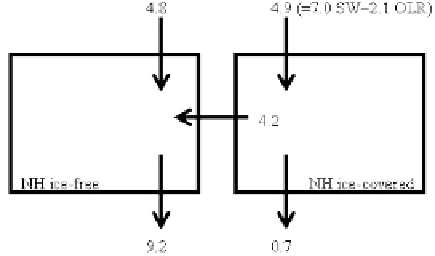Geoscience Reference
In-Depth Information
has been explored in the IPCC AR4 climate models. Five
models supplying SRES A1B ensembles for the 21st century
were examined, and very linear relationships were found be-
tween polar and global temperatures indicating linear Arctic
climate change. The relationship between polar temperature
and albedo is also linear in spite of the appearance of ice-free
Septembers in four of the five models.
Two of the IPCC climate models have Arctic Ocean simu-
lations that become annually sea ice-free under the stronger
CO
2
increase to quadrupling forcing. Both runs show in-
creases in polar amplification at polar temperatures above
−5°C, and one exhibits heat budget changes that are con-
sistent with the small ice cap
instability of simple energy
balance models. Both models show linear warming up to a
polar temperature of −5°C, well above the disappearance
of their September ice covers at about −9°C. Below −5°C,
surface albedo decreases smoothly as reductions move, pro-
gressively, to earlier parts of the sunlit period. Atmospheric
heat transport exerts a strong cooling influence during the
transition to annually ice-free conditions.
Specialized experiments with atmosphere and coupled
models show that perturbations to the sea ice region climate
are opposed by changes in the heat flux through the adja-
cent ice-free oceans conveyed by altered atmospheric heat
transport into the sea ice region. This, rather than OlR,
is the main damping mechanism of sea ice region surface
temperature. This strong damping along with the weakness
of the surface albedo feedback during the emergence of an
ice-free period late in the sunlit season are the main reasons
for the linearity of Arctic climate change and the stability of
seasonal ice covers found in the IPCC models.
Support for these mechanisms can be found in simple
models.
Thorndike
's [1992] “toy” model shows their impor-
tance by demonstrating the consequences of their absence.
In order to make the “toy” model analytically tractable, the
ice experiences a constant insolation in the summer season.
This disables the seasonal adjustment of albedo feedback just
mentioned. Furthermore, the Thorndike model has only weak
surface temperature damping to space through a gray body
atmosphere. Atmospheric heat transport convergence is held
fixed. The result is a model that has no stable seasonal cy-
cle with ice-covered and ice-free periods: the model is either
annually ice covered or annually ice free.
Eisenman
[2007]
has enhanced the Thorndike model with a sinusoidal insola-
tion and temperature sensitive atmospheric heat transport and
finds stable seasonally ice-free seasonal cycles over a broad
range of CO
2
forcings, from 2 to 15 times current levels.
Figure 5.
Difference in atmospheric heat fluxes over ice-covered
and ice-free regions of the Northern Hemisphere between ice-albedo
reduced and control coupled model runs. The “ice-covered” region
is defined by the annual mean ice concentration of the control ex-
periment. All fluxes are in units of W m
−2
ice-covered region.
duction of atmospheric heat transport convergence into the
ice-covered region (defined from the control experiment).
There is also some net downward flux at the surface in the
ice-covered region which is mainly supported by reduced la-
tent heating because of the reduced sea ice export in thinner
ice. This change in sea ice transport has a salinifying influ-
ence near the sea ice edge. Again, the reduced heat trans-
port into the Arctic is supported by a reduction in heat flux
out of the adjacent ocean surface. But this response is now
oversized compared with the changes in the sea ice region.
The reason for this is that, in spite of the change in sea ice
freshwater forcing, reduced ocean heat extraction caused
by reducing sea ice albedo has induced a reduction of the
meridional overturning circulation (MOC). This is shown in
Plate 9 along with the change in deepwater ages averaged
over the 100 years. The reduction in deepwater ventilation
agrees with the result of a similar sea ice albedo reduction
experiment performed by
Bitz
et al
. [2006] with the NCAR
CCSM3. The CCSM3 response was relatively larger in the
Southern Ocean, perhaps because the CCSM3 has more
Southern Ocean sea ice to feel the albedo reduction than
GFdl's CM2.1.
7. SuMMARy ANd dISCuSSION
The potential for sea ice-albedo feedback to give rise to
nonlinear climate change in the Arctic Ocean, defined as a
nonlinear relationship between polar and global temperature
change or, equivalently, a time-varying polar amplification,
Plate 8.
(Opposite)
Change in heat fluxes at the (top) top and (bottom) bottom of the atmosphere and (middle) the change in atmospheric
heat transport convergence for the AMIP ice removal experiment.


Search WWH ::

Custom Search